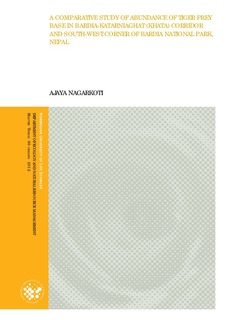A comparative study of abundance of tiger prey base in Bardia-Katarniaghat (Khata) corridor and south-west corner of Bardia National Park, Nepal
Master thesis
Permanent lenke
http://hdl.handle.net/11250/186875Utgivelsesdato
2012-09-12Metadata
Vis full innførselSamlinger
- Master's theses (INA) [593]
Sammendrag
The current study was carried out in Bardia National Park and in the Bardia-Katarniaghat
(Khata) corridor, which is one of five priority areas identified by Terai Arc Landscape Program
(TAL) for habitat restoration due to heavy degradation of forest. The study was conducted from
15th October to 26th November 2011. The main objectives of the study were to compare the
composition and abundance of tiger prey in both study areas and to draw inference on tiger
habitat quality in the corridor. The line-plot pellet count technique of Wegge (1976) was
adopted to assess the composition and abundance of tiger prey. Habitat compositions in the
park and the corridor were determined on the basis of proportional length of different habitats
along transects. Land use changes in the corridor from 1997 to 2011 were found out by the help
of GIS using a topographic map and a Google Earth image.
Corridors are connections between separate areas of similar habitat (Bolen & Willam 1995) and
geographical extensions, continental or maritime, whose function is to connect areas and
facilitate the movement of plants and animals and provide natural conditions that guarantee
their conservation (Rivera et al. 2002). The study found out that the abundance of major tiger
prey species like chital (Axis axis) and hog deer (A. porcinus) was extremely low in the Khata
corridor compared to the south-western part of the park. The less abundant swamp deer (Cervus
duvauceli) was restricted to phanta in the park, but was absent in the corridor. Other preferred
prey species, such as sambar deer (C. unicolor) was rare in the park, but absent in the corridor.
Similarly, nilgai (Boselaphus tragocamelus) and barking deer (Muntiacus muntjac) were scarce
in both study areas. Livestock pellet groups were recorded only in the corridor with the highest
abundance after wild boar. Relatively small areas of important prey habitats like phanta and
tallgrass floodplain ((p ≤ 0.05) in the corridor than in the park, and their poor quality was the
main reason for the low density of chief tiger prey species in the corridor.
Habitat assessment in the Khata corridor showed that the forest area remained unchanged and
there was an insignificant increase in other land types from 1997 to 2011. The study indicated
that the effect of past anthropogenic activities, current excessive livestock pressure and
infestation of the alien plant Lantana camara were important factors affecting the habitat
quality in the corridor. This suggested that tiger habitat quality was not satisfactory in the
corridor. Nevertheless, the higher density of wild boar in the corridor may fulfill the feeding
requirements of the tiger and can help its transboundary dispersal in some extent. On the other
hand, the tiger population may increase with the restoration of habitats, which in turn may
increase tiger human conflicts due to the small habitat area. All these issues should be
addressed to restore the tiger habitat in the Khata corridor and facilitate its smooth dispersal
through it.
